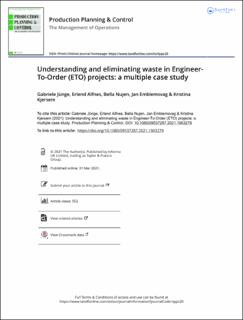| dc.contributor.author | Jünge, Gabriele Hofinger | |
| dc.contributor.author | Alfnes, Erlend | |
| dc.contributor.author | Nujen, Bella B. | |
| dc.contributor.author | Emblemsvåg, Jan | |
| dc.contributor.author | Kjersem, Kristina | |
| dc.date.accessioned | 2021-10-13T06:35:30Z | |
| dc.date.available | 2021-10-13T06:35:30Z | |
| dc.date.created | 2021-03-31T17:55:57Z | |
| dc.date.issued | 2021 | |
| dc.identifier.citation | Production planning & control (Print). 2021, . | en_US |
| dc.identifier.issn | 0953-7287 | |
| dc.identifier.uri | https://hdl.handle.net/11250/2789485 | |
| dc.description.abstract | This article explores how waste reduction approaches as found in lean thinking can be applied to engineering design in Engineer-To-Order (ETO) projects based on a multiple case study of ten companies over a 2-year period. ETO projects deliver capital goods that are customised to individual customer requirements. Customisation and ultimately value generation are achieved through an iterative engineering design process. Although inevitable, iterative engineering design allows much leeway for waste generation, expressed in higher costs and longer lead times. Accordingly, this paper investigates the iterative nature of engineering design in current practice and discusses how these iterations create wastes. It applies the concept of lean engineering design and elaborates on how this concept can eliminate wastes. The findings extend the literature on lean thinking by demonstrating its applicability to engineering design and provide a unique description of the most common wastes found in ETO projects. Furthermore, this article provides managerial implications on how lean engineering design can eliminate wastes and ultimately improve ETO project performance based on lessons learned from the case companies. | en_US |
| dc.language.iso | eng | en_US |
| dc.publisher | Taylor and Francis | en_US |
| dc.rights | Attribution-NonCommercial-NoDerivatives 4.0 Internasjonal | * |
| dc.rights.uri | http://creativecommons.org/licenses/by-nc-nd/4.0/deed.no | * |
| dc.title | Understanding and eliminating waste in Engineer-To-Order (ETO) projects: a multiple case study | en_US |
| dc.type | Journal article | en_US |
| dc.type | Peer reviewed | en_US |
| dc.description.version | publishedVersion | en_US |
| dc.source.pagenumber | 17 | en_US |
| dc.source.journal | Production planning & control (Print) | en_US |
| dc.identifier.doi | 10.1080/09537287.2021.1903279 | |
| dc.identifier.cristin | 1901867 | |
| cristin.ispublished | true | |
| cristin.fulltext | original | |
| cristin.qualitycode | 1 | |

